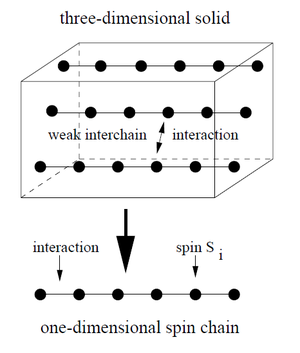S=1/2 and S=1 one dimensional quantum magnets
Why are we interested in one-dimensional magnetism? Magnetism in one dimension are of highly theoretical interest as well as there are a variety of highly interesting experimental systems. Most two-dimensional magnets order at T=0, however, in one-dimensional situation, fluctuations are so strong that at T=0 most magnets are disordered. Because of the strong fluctuations, conventional techniques are normally not applicable. So we need to search for new tools to solve problems. One of the representative way is to use numerical methods. An example is, by numerically evaluation, one found a unique, disorder ground state of the nearest-neighbor isotropic anti-ferromagnetic Heisenberg chain for spins S=1/2, with anti-ferromagnetic spin-spin correlations, referred as quasi long-range ordered.
Haldane's Conjecture
Introduction to Haldane's Conjecture
Haldane conjectured a fundamental difference between spin chains with S an integer and S a half-integer. He mapped out anti-ferromagnetic isotropic Heisenberg chains to an effective low-energy long-wavelength field theory. Here we use effective field theories of anti-ferromagnets to show Haldane's Conjecture.
Let's consider an isotropic anti-ferromagnetic Heisenberg model with nearest neighbor interaction between spins of S length.The Hamiltonian can be expressed as
Verify Haldane's Conjecture in S=1/2 case
Verify Haldane's Conjecture in S=1 case
Microscopic Description of Haldane Magnets
Quantum Disorder and Lifshitz Points
References
- ↑ Cite error: Invalid
<ref>tag; no text was provided for refs namedUlrich Schollwock




![{\displaystyle Q[{\overset {\rightarrow }{\phi }}]={\frac {1}{\Theta }}\int {d^{2}x}{\mathcal {L}}_{TOP}[{\overset {\rightarrow }{\phi }}]}](https://wikimedia.org/api/rest_v1/media/math/render/svg/0c30eb114e30ba86488e6c701e0dbef9fd417c7f)
![{\displaystyle Z=\int D[{\overset {\rightarrow }{\phi }}]e^{-\int {d^{2}x}{\mathcal {L}}_{NL}}e^{-i\Theta Q[{\overset {\rightarrow }{\phi }}]}\delta \left(|{\overset {\rightarrow }{\phi }}|^{2}\right)}](https://wikimedia.org/api/rest_v1/media/math/render/svg/02305822d102854b016d983d1d1d6ef0f8d542f0)

![{\displaystyle \left\langle \mathbf {S} _{i}\cdot \mathbf {S} _{j}\right\rangle \propto \left(-1\right)^{i-j}{\frac {e^{-|i-j|/\xi }}{\sqrt[{2}]{|i-j|}}}}](https://wikimedia.org/api/rest_v1/media/math/render/svg/ab3dc882245b60060cf94b4f024ccff5eeac88a0)
![{\displaystyle E\left(k\right)={\sqrt[{2}]{\Delta ^{2}+v^{2}\left(k-\pi \right)^{2}}}}](https://wikimedia.org/api/rest_v1/media/math/render/svg/b32c5418726edb681a213ead8a4d761e3b771e6f)

